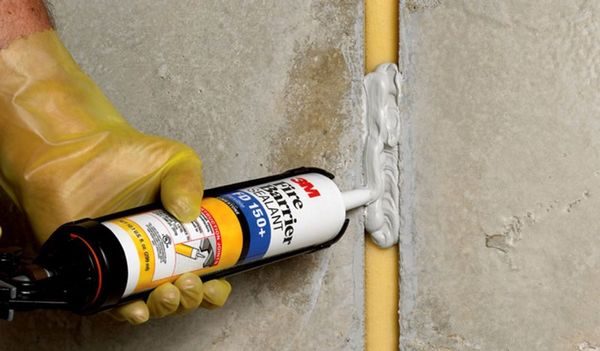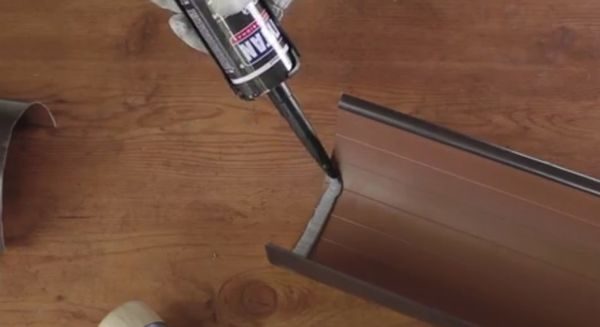The main task of rubber sealant is to fill cracks, potholes, chips, cracks and other defects. Having a special composition, this tool allows you to create a sealing seam that does not allow the ingress of moisture and dust.
- What are rubber sealants?
- Main properties and features
- Application area
- Advantages and disadvantages
- Popular rubber sealants
- Rubber Sealant for Roofing Tytan
- Penosil Premium All Weather Sealant
- Body 920
- MasterTeks Rubber Sealant Liquid Rubber
- TechnoNIKOL No. 45

Rubber based sealants are in demand in the construction industry. They are used in a wide range of works. They are no less popular in everyday life, as they help to solve many problems.
What are rubber sealants?
During the production of these products, synthetic rubber is used. Often manufacturers add other materials:
- fibers that improve the bonding of components;
- solvents to achieve optimal consistency;
- resins that give sealants additional properties.
Today bituminous and butyl rubber sealants are on sale. Each type has its own characteristics and is intended for a certain range of work.
to contents ↑Main properties and features
These products are excellent for filling / sealing defects on vertical and horizontal surfaces. One of the important advantages is the rapid polymerization upon contact with moisture contained in the air. Due to this, rubber sealants cure after extrusion from the tube. On the market you can find one- and two-component compositions with high performance characteristics.
The polymerization process is fast enough, but allows you to create / adjust the seal. The resulting seam has a rubber-like structure: moderately elastic and durable. Resistance to UV radiation is a key feature of modern sealants based on synthetic rubber. Due to it, these funds are suitable for outdoor work.
Other properties of rubber sealants include:
- increased resistance to mechanical stress (hardened seam is difficult to damage with anything, it retains elasticity over a long period of operation);
- immunity to weathering (a wide range of temperatures makes rubber sealants insensitive to seasonal differences, as well as to precipitation);
- good adhesion (due to this property, sealants acquire high adhesion to various surfaces);
- frost resistance (these products retain their qualities even when frozen to –50 degrees Celsius).
The complete curing of rubber sealants takes an average of 1-2 days, depending on the composition. In general, these products are very similar in properties to silicone compounds, but have many advantages over them.
The most commonly used black sealant.Dark color is acquired during a chemical reaction between the basic components. Also there are funds of other colors: red, white, brown.
to contents ↑Application area
These compounds are suitable for various work indoors and outdoors. Rubber sealants are indispensable for bonding all kinds of surfaces. They create a protective layer that protects structural elements from negative environmental factors.
Rubber sealants are suitable for the following applications:
- joints of deformation joints;
- repair / sealing of the roof covering (taking into account various materials: metal tile, ondulin and others);
- elimination of technical gaps between structural elements;
- dealing with leaks caused by decay / deformation of the structure;
- seams between ceramic tiles in the bathroom and in the kitchen.
Good adhesion makes rubber sealants indispensable when working with metal, concrete, wood, natural / artificial stone, glass. In this they differ from silicone-based products.
The sealant creates a seam that provides high moisture protection of window openings. It is used for processing attics and gutters.
to contents ↑
Advantages and disadvantages
Rubber compounds have a large number of advantages. A distinctive feature is a long service life of up to 20 years. This reduces the cost of restoring and maintaining sealing joints.
Sealants work well with most known materials. They are indispensable in large and small construction, during the repair, restoration and installation works. Other benefits include:
- corrosion resistance and a high level of surface protection against rust;
- the possibility of staining, which makes the seam more attractive;
- elasticity that does not allow the sealing joint to crack with time;
- moisture resistance, which is especially important when conducting outdoor work;
- use even on wet surfaces.
Rubber sealants are so practical and effective that they do not need preliminary cleaning of the surface. Despite this, they have a number of disadvantages. These compounds are not recommended for use with plastic: aggressive components of the sealant can lead to damage to parts and surfaces.
Softening in contact with oils is another drawback. This applies directly to automotive rubber sealants, so care must be taken when handling them.
to contents ↑Popular rubber sealants
It was noted above that the variety of these funds is great. This opens up great opportunities for choosing the composition, taking into account the nature of the task.
Construction / hardware stores receive imported and domestic sealants. It is recommended to choose the product that has passed the technical control and meets the applicable norms and standards (the package must have a corresponding mark).
To make the choice of rubber sealant as simple and quick as possible, we provide a useful overview of leading manufacturers and well-known products.
to contents ↑Rubber Sealant for Roofing Tytan
The products of this brand are well known and loved in our country, as it has proven itself perfectly. Tytan allows you to create a reliable waterproof compound that can withstand ambient temperature in the range from –55 to +100 degrees Celsius.
Resistance to fungi and mold is an important feature of this composition. This allows you not to fear the development of microorganisms in hard-to-reach places (joints between tiles, cracks between the bathroom and the wall). Sealant is indispensable for processing:
- roof skates;
- roof windows;
- sewer manholes;
- gutters;
- storm systems;
- ventilation.
For ease of use, Tytan rubber sealant is available in 310 ml tubes. It is curious that the tool is able to withstand up to four freezing cycles, while maintaining its consumer qualities.
Apply this sealant at a positive air temperature. The cure rate is approximately 2 mm per day.
to contents ↑
Penosil Premium All Weather Sealant
The main advantage of this sealant is its excellent adhesion to the surface in conjunction with a viscous consistency. The tool does not drain even from vertical panels and partitions, holding onto them and hardening gradually.
Penosil sealant is indispensable when working with brick / masonry, monolithic concrete surfaces, glass, wood and metal. In addition, he is not so aggressive towards plastic. Full hardening occurs 20 minutes after removal from the cartridge.
Like the previous composition, this sealant is resistant to mold. An important difference is the application even at a temperature of –5 degrees Celsius, which expands the possibilities for using the product.
to contents ↑Body 920
A thick consistency, surface stability, and crack protection are the main advantages of the Body 920 one-component rubber sealant. It is non-aggressive to plastic, has good adhesion to metal parts and perfectly glues / seals joint seams.
Due to its availability, this composition is actively used in the processing of air conditioning systems. It is used in the construction of small vessels made of metal and wood, as well as for sealing sea containers and processing elements of a car body.
to contents ↑MasterTeks Rubber Sealant Liquid Rubber
This tool is good in that it is suitable for work in any season and regardless of weather conditions. Made on the basis of butyl acetate and synthetic rubber, this sealant is used to restore roofing and protect rafter systems from the harmful effects of moisture.
The composition has a narrower range of operating temperatures (from –40 to +90 degrees Celsius), but it can be applied even at 10 degrees below zero. Liquid rubber is excellent for working in rooms with high humidity and is often used to seal the building facades.
to contents ↑TechnoNIKOL No. 45
Another no less popular butyl rubber sealant, which became known due to:
- cold curing;
- low gas permeability;
- elasticity of the seam;
- application at a temperature of –20 degrees Celsius.
This sealant has a neutral white color and is well suited for painting. It is durable. Full drying occurs an hour after application. For ease of use, the product is available in buckets weighing up to 16 kg.
These sealants passed technical control and a number of tests, and most importantly, were tested in practice. These funds are available not only for professional builders, but also for ordinary consumers, which affected the growth of their popularity.
















